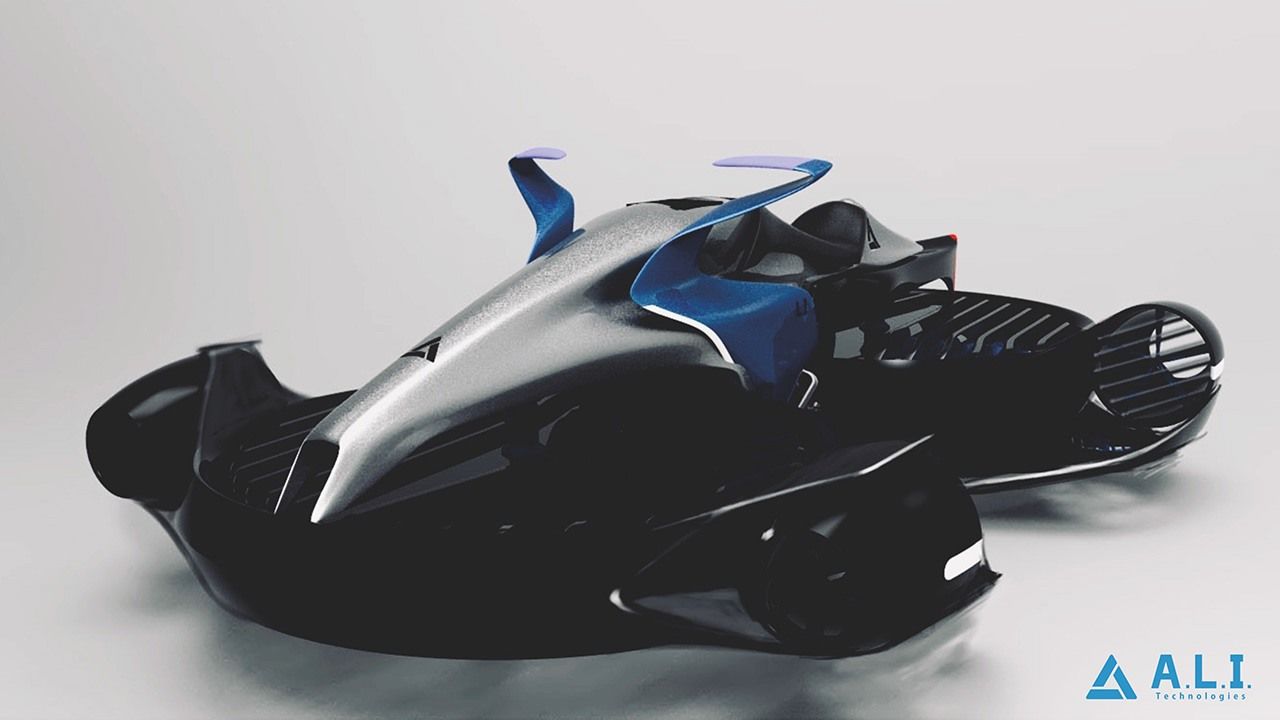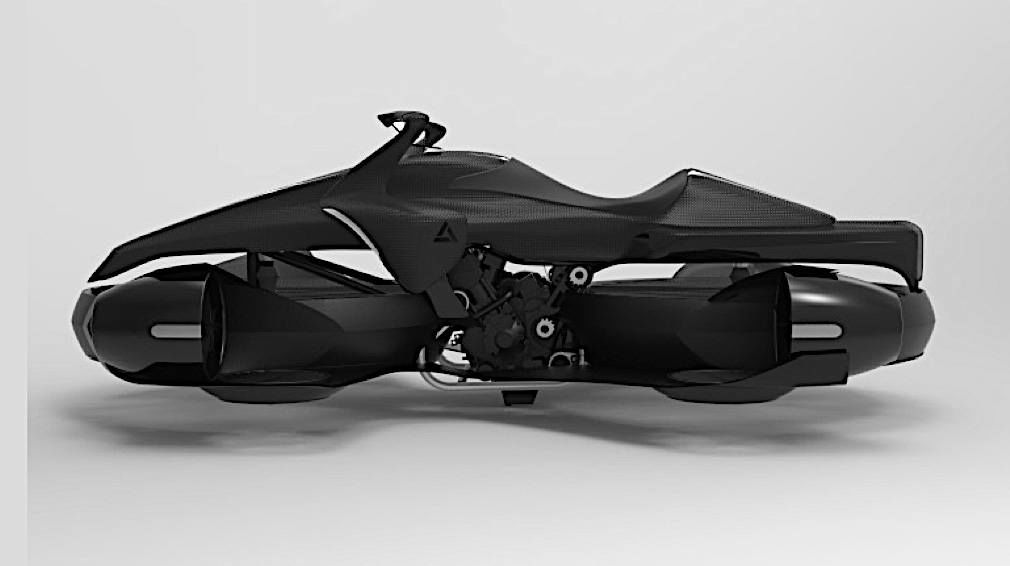
Tired of Traffic? Take to the Skies with ALI Technologies’ Flying Bike
Economy Science Society Lifestyle Environment- English
- 日本語
- 简体字
- 繁體字
- Français
- Español
- العربية
- Русский
“It’s a rare company that tackles both air infrastructure and air mobility,” says Katano Daisuke, president of ALI Technologies, headquartered in Minato, Tokyo. He continues, “I think there’s only one other company like ours, and it’s in Israel. Our company is working to achieve an air mobility society in which traffic accidents never happen.” ALI Technologies was established in September 2016 by a group of University of Tokyo student entrepreneurs developing drones.

Katano Daisuke, president of ALI Technologies.
We’ll get to the “air mobility society” later, but first let’s take a look at the “flying bike,” the airborne vehicle that will play a central role in the society sketched out by Katano and his firm.
Development of the novel vehicle is still underway, but a prototype was flown in a demonstration for the press in March, and the latest version, the Xturismo Limited Edition, went on display at the forty-sixth Tokyo Motor Show at Tokyo Big Sight. There was no demonstration of the bike in action, however.
The plan is to have the new vehicle ready for delivery by the latter half of next year and to have it licensed under the provisions of Japan’s Road Transport Vehicle Act as a transport vehicle for public roads by 2023, when it will bear a license plate, just like a car or conventional motorcycle. Mass production of models including an electric vehicle is scheduled to begin in that year.
A Hybrid Vehicle with Propellers
So how does the flying bike work? “Lift is provided by rotating propellers, just like those on drones and helicopters,” says Katano. Speaking prior to the Tokyo Motor Show, he declined to go into details of size, weight, speed, or design, but did explain that it was a single-rider vehicle.
The body of the vehicle, which looks more like a snowmobile than a motorcycle, has two propellers aligned front and back on its underside. The rider straddles the body resting on the two propellers just like one would ride a motorcycle. A cowl on the front and an exhaust duct at the rear help to maximize lift, explains Katano.

A side view of the Xturismo Limited Edition.
Four sub-propellers for controlling movement are placed front and back, left and right on the vehicle. The vehicle is a hybrid type powered by a gasoline engine and electric battery. The ALI Technologies engineers say they sought to achieve a safe and compact vehicle by installing a gasoline engine to ensure sufficient and sustained driving power even with small propellers. They also added small, motor-driven propellers on either side of the vehicle to maintain posture control.
And there you have it: a vehicle that floats like a hovercraft and moves in three-dimensional space. Katano refuses to reveal how fast the new vehicle can go. “As for speed, all I can say right now is that we are aiming to produce a 200-kilometer-per-hour model.” He also makes no statement on how high the vehicle can hover. If it will be used on public roads, the likelihood is that it will be set to hover roughly 50 centimeters above the road surface, with the potential to go higher.
The product concept for the vehicle, says Katano, is the “fusion of compact size and design” and this is why there are only two propellers providing lift instead of four. He also notes that design was a critical feature from the start. “Our strategy is similar to that of Tesla Motors, the American EV auto company. We plan to start by marketing exclusive, high-end models, and after we’ve established our market, we’ll shift to mass production.”
Tesla has built mindshare by targeting affluent buyers with sports cars and high-end luxury models, a strategy that has helped to promote the development of EV vehicles worldwide. It did not begin selling mass-produced models until the market was well established. ALI Technologies intends to follow the same kind of strategy.
A New Tool for Disaster Rescue
Now that the technology is in place for the flying bike, the shift is toward developing practical applications. Still, its airborne feature means there are numerous safety and legal hurdles to overcome, as well as a need for public acceptance. In its action plan for growth strategy published in June 2019, the Japanese government announced that it will aim to have policies and regulations in place in time for businesses to launch their airborne vehicle lines by 2013.
ALI Technologies has appointed Yasutomi Masafumi, a former vice transport minister, as its special advisor and is hoping to secure licenses for its airborne vehicles to be used on public roads by 2023. Until then, the vehicles will only be usable in areas other than public roads. Possibilities include open fields, lakes, deserts, and wetlands, or even areas where unexploded ordnance is present. Uses that will benefit society will take precedent over personal applications.
Hopes are high that the new airborne vehicles will be especially useful for search and rescue missions following typhoons and earthquakes. This year’s Typhoon Hagibis wreaked havoc in many areas of the country, with major flooding along rivers in central and eastern Honshū. Large-scale typhoons of this type are said to be exacerbated by climate change, and a failure over many years to properly manage forestland is also being pointed to as a factor in aggravating the resulting damage. Already prone to natural disasters, Japan can expect more in the near future.
Flying bikes, with their greater maneuverability, could prove to be even more useful than helicopters for rescue missions over flooded areas. The vehicles could be used to gather real-time information, deliver food and water to people trapped in their homes until they can be rescued, and otherwise serve as an invaluable lifeline.
By the time mass production commences in 2023, the airborne vehicles appearing on the market will include fully EV models, eliminating the need for fossil fuels and further enhancing the environmental durability of the vehicles. With motors instead of engines as the power source, noise levels will also be significantly lowered. Solar panels and converters to generate electricity further eliminate the need for liquid fuels, making it possible to use the airborne vehicles in just about any kind of environment, including desert regions and landmine danger zones.
The biggest problem at the moment is the capacity of the vehicle’s lithium batteries. Katano says that at the moment they are aiming for two hours of driving time with one full charge of the batteries. Steady progress has been made in developing lithium cell technology since the first viable version was created by Yoshino Akira, an Asahi Kasei Corporation fellow and Nobel laureate. As the batteries become more powerful and lighter in weight, it will be possible for vehicles to operate for longer times and distances, opening the way for more flexibility in design as well.
No More Traffic Accidents
Even as it makes progress on advancing air mobility technology, ALI Technologies is also working to build infrastructure for airborne traffic, including three-dimensional control systems and air route designs.
As is demonstrated by the latest buzzword in the automotive industry, the acronym CASE—which stands for connected, autonomous, shared, and electrified—the automobile is at a once-in-a-century turning point in its history. The focus is especially strong on cutting down on traffic accidents by developing self-driving electric vehicles with a high degree of controllability.
Says Katano, “Self-driving vehicle mobility is easier to achieve in a three-dimensional rather than a two-dimensional context. The lack of obstacles make it easier to control the vehicle.” As ALI Technologies strives to realize the air mobility society, he continues, “our mission is to eliminate traffic accidents altogether.”
ALI Technologies was formed on the basis of a business plan for a flying bike developed by Komatsu Shūhei, who became the company president in February 2017. He is now its chairman. After earning his engineering degree from the University of Tokyo, Katano worked as a consultant for major corporations and helped with a number of new startup businesses before joining ALI Technologies and taking over as president in July 2018.
Komatsu and Katano work in tandem in guiding the firm, with Komatsu overseeing technology development and Katano taking responsibility for overall management of the company. There relationship resembles that of Honda Sōichirō and Fujisawa Takeo in the early days of the Honda Motor Company.
“I’m an indoor person,” says Katano. “I prefer video games over golf.” An avid Dragon Quest fan, Katano is always looking ahead and is planning to develop a “flying car” once the bike business takes off—literally.
(Originally published in Japanese. Banner photo: The Xturismo Limited Edition on display at the 2019 Tokyo Motor Show.)